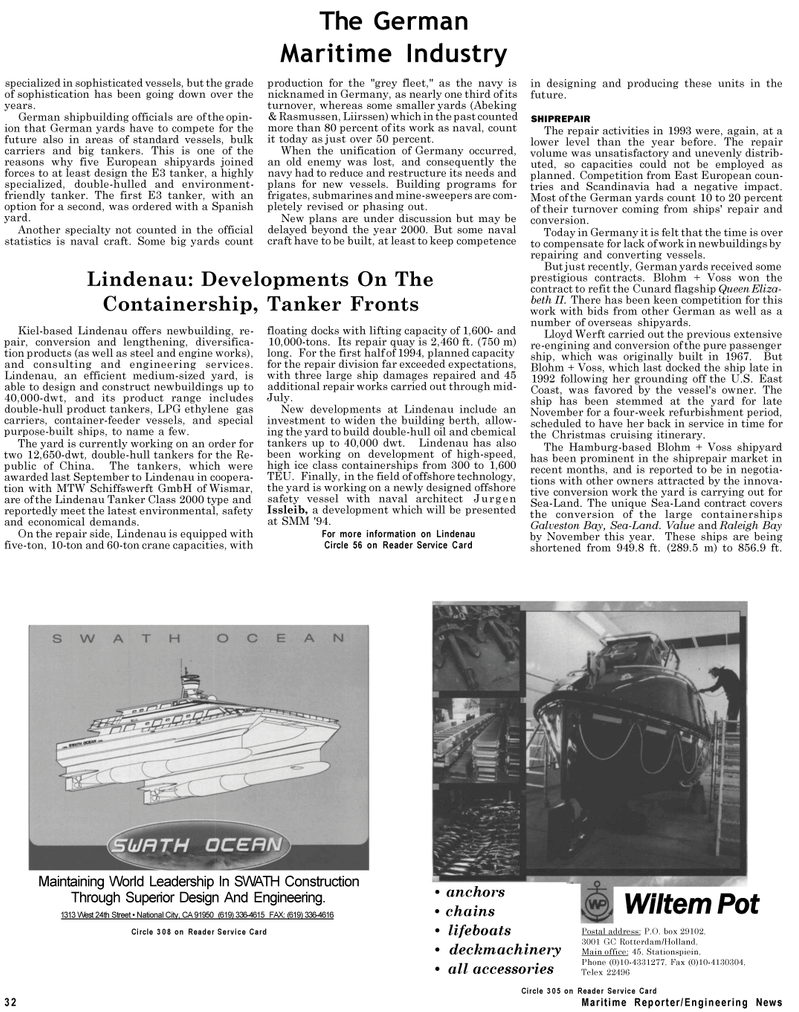
Page 30: of Maritime Reporter Magazine (September 1994)
Read this page in Pdf, Flash or Html5 edition of September 1994 Maritime Reporter Magazine
specialized in sophisticated vessels, but the grade of sophistication has been going down over the years.
German shipbuilding officials are of the opin- ion that German yards have to compete for the future also in areas of standard vessels, bulk carriers and big tankers. This is one of the reasons why five European shipyards joined forces to at least design the E3 tanker, a highly specialized, double-hulled and environment- friendly tanker. The first E3 tanker, with an option for a second, was ordered with a Spanish yard.
Another specialty not counted in the official statistics is naval craft. Some big yards count
The German
Maritime Industry production for the "grey fleet," as the navy is nicknamed in Germany, as nearly one third of its turnover, whereas some smaller yards (Abeking & Rasmussen, Liirssen) which in the past counted more than 80 percent of its work as naval, count it today as just over 50 percent.
When the unification of Germany occurred, an old enemy was lost, and consequently the navy had to reduce and restructure its needs and plans for new vessels. Building programs for frigates, submarines and mine-sweepers are com- pletely revised or phasing out.
New plans are under discussion but may be delayed beyond the year 2000. But some naval craft have to be built, at least to keep competence
Lindenau: Developments On The
Containership, Tanker Fronts
Kiel-based Lindenau offers newbuilding, re- pair, conversion and lengthening, diversifica- tion products (as well as steel and engine works), and consulting and engineering services.
Lindenau, an efficient medium-sized yard, is able to design and construct newbuildings up to 40,000-dwt, and its product range includes double-hull product tankers, LPG ethylene gas carriers, container-feeder vessels, and special purpose-built ships, to name a few.
The yard is currently working on an order for two 12,650-dwt, double-hull tankers for the Re- public of China. The tankers, which were awarded last September to Lindenau in coopera- tion with MTW Schiffswerft GmbH of Wismar, are of the Lindenau Tanker Class 2000 type and reportedly meet the latest environmental, safety and economical demands.
On the repair side, Lindenau is equipped with five-ton, 10-ton and 60-ton crane capacities, with floating docks with lifting capacity of 1,600- and 10,000-tons. Its repair quay is 2,460 ft. (750 m) long. For the first half of 1994, planned capacity for the repair division far exceeded expectations, with three large ship damages repaired and 45 additional repair works carried out through mid-
July.
New developments at Lindenau include an investment to widen the building berth, allow- ing the yard to build double-hull oil and cbemical tankers up to 40,000 dwt. Lindenau has also been working on development of high-speed, high ice class containerships from 300 to 1,600
TEU. Finally, in the field of offshore technology, the yard is working on a newly designed offshore safety vessel with naval architect Jurgen
Issleib, a development which will be presented at SMM '94.
For more information on Lindenau
Circle 56 on Reader Service Card in designing and producing these units in the future.
SHIPREPAIR
The repair activities in 1993 were, again, at a lower level than the year before. The repair volume was unsatisfactory and unevenly distrib- uted, so capacities could not be employed as planned. Competition from East European coun- tries and Scandinavia had a negative impact.
Most of the German yards count 10 to 20 percent of their turnover coming from ships' repair and conversion.
Today in Germany it is felt that the time is over to compensate for lack of work in newbuildings by repairing and converting vessels.
But just recently, German yards received some prestigious contracts. Blohm + Voss won the contract to refit the Cunard flagship Queen Eliza- beth II. There has been keen competition for this work with bids from other German as well as a number of overseas shipyards.
Lloyd Werft carried out the previous extensive re-engining and conversion of the pure passenger ship, which was originally built in 1967. But
Blohm + Voss, which last docked the ship late in 1992 following her grounding off the U.S. East
Coast, was favored by the vessel's owner. The ship has been stemmed at the yard for late
November for a four-week refurbishment period, scheduled to have her back in service in time for the Christmas cruising itinerary.
The Hamburg-based Blohm + Voss shipyard has been prominent in the shiprepair market in recent months, and is reported to be in negotia- tions with other owners attracted by the innova- tive conversion work the yard is carrying out for
Sea-Land. The unique Sea-Land contract covers the conversion of the large containerships
Galveston Bay, Sea-Land. Value and Raleigh Bay by November this year. These ships are being shortened from 949.8 ft. (289.5 m) to 856.9 ft.
Maintaining World Leadership In SWATH Construction
Through Superior Design And Engineering. 1313 West 24th Street • National City, CA 91950 (619) 336-4615 FAX: (619) 336-4616
Circle 308 on Reader Service Card 32
Circle 305 on Reader Service Card
Maritime Reporter/Engineering News • anchors • chains • lifeboats • deckmachinery • all accessories
Wiltem Pot
Postal address: P.O. box 29102, 3001 GC Rotterdam/Holland,
Main office: 45, Stationspiein,
Phone (0)10-4331277, Fax (0)10-4130304,
Telex 22496

 29
29

 31
31
